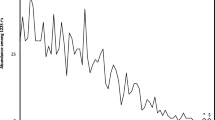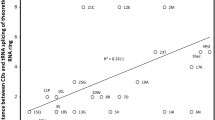Summary
The specificity of interaction of amino acids with triplets in the acceptor helix stem of tRNA was investigated by means of a statistical analysis of 1400 tRNA sequences. The imprint of a prototypic genetic code at position 3–5 of the acceptor helix was detected, but only for those major amino acids, glycine, alanine, aspartic acid, and valine, that are formed by spark discharges of simple gases in the laboratory. Although remnants of the code at position 3–5 are typical for tRNAs of archaebacteria, eubacteria, and chloroplasts, eukaryotes do not seem to contain this code, and mitochondria take up an intermediary position. A duplication mechanism for the transposition of the original 3–5 code toward its present position in the anticodon stern of tRNA is proposed. From this viewpoint, the mode of evolution of mRNA and functional ribosomes becomes more understandable.
Similar content being viewed by others
References
Amons R, Van Agthoven A, Pluijms W, Möller W, Higo K, Itoh T, Osawa S (1977) A comparison of the amino-terminal sequence of the L7/L 12-type proteins of Artemia salina and Saccharomyces cerevisiae. FEBS Lett 81:308–310
Auer J, Lechner K, Böck A (1989) Gene organization and structure of two transcriptional units from Methanococcus coding for ribosomal proteins and elongation factors. Can J Microbiol 35:200–204
Burbaum JJ, Schimmel P (1991) Structural relationships and the classification of aminoacyl-tRNA synthetases. J Biol Chem 266:16965–16968
Crick FHC (1968) The origin of the genetic code. J Mol Biol 38:367–379
Cusack S, Berthet-Colominas C, Härtlein M, Nassar N, Leberman, R (1990) A second class of synthetase structure revealed by X-ray analysis of Escherichia coli seryl-tRNA synthetase at 2.5 Å. Nature 347:249–255
Darnell JE, Doolittle WF (1986) Speculations on the early course of evolution. Proc Natl Acad Sci USA 83:1271–1275
De Duve C (1988) The second genetic code. Nature 333:117–118
Eigen M, Schuster P (1978) The hypercycle: a principle of natural self-organization; part C: the realistic hypercycle. Naturwissenschaften 65:341–369
Eigen M, Winkler-Oswatitsch R (1981a) Transfer-RNA, an early gene? Naturwissenschaften 68:282–292
Eigen M, Winkler-Oswatitsch R (1981b) Transfer-RNA: the early adaptor Naturwissenschaften 68:217–228
Eriani G, Delarue M, Poch O, Gangloff J, Moras D (1990) Partition of tRNA synthetases ito two classes based on mutually exclusive sets of sequence motifs. Nature 347:203–206
Goodman HM, Olson MV, Hall BD (1977) Nucleotide sequence of a mutant eukaryotic gene: the yeast tyrosine-inserting ochre suppressor SUP4-o. Proc Natl Acad Sci USA 74:5453–5457
Goodman R (1964) Modern statistics. Arc Books, New York
Guerrier-Takada C, Gardiner K, Marsh T, Pace N, Altman S (1983) The RNA moiety of ribonuclease P is the catalytic subunit of the enzyme. Cell 35:849–857
Hou YM, Schimmel P (1988) A simple structural feature is a major determinant of the identity of a transfer RNA. Nature 333:140–145
Inoue T, Orgel LE (1983) A nonenzymatic RNA polymerase model. Science 219:859–862
Joyce GF (1989) RNA evolution and the origin of life. Nature 338:217–224
Jukes TH, Osawa S (1991) Recent evidence for evolution of the genetic code. In: Osawa S, Honjo T (eds) Evolution of life. Springer, Tokyo, pp 79–95
Jungck JR (1978) The genetic code as a periodic table. J Mol Evol 11:211–224
Kim SH, Suddath FL, Quigley GJ, McPherson A, Sussman JL, Wang A, Seeman NC, Rich A (1974) The three-dimensional structure of transfer RNA. Science 185:435–440
Kvenvolden KA, Lawless J, Pering K, Peterson E, Flores J, Ponnamperuma C, Kaplan IR, Moore C (1970) Evidence for extraterrestrial amino acids and hydrocarbons in the Murchison meteorite. Nature 288:923–926
Matheson AT, Möller W, Amons R, Yaguchi M (1980) Comparative studies on the structure of ribosomal proteins with emphasis on the alanine-rich, acidic ribosomal ‘A’ protein. In: Chambliss G, Craven GR, Davies J, Davis K, Kahan L, Nomura M (eds) Ribosomes; structure, function and genetics. University Park Press, Baltimore, pp 297–332
Miller SL (1986) Current status of the prebiotic synthesis of small molecules. Chem Scr 26B:5–11
Möller W, Janssen GMC (1990) Transfer RNAs for primordial amino acids contain remnants of a primitive code at position 3 to 5. Biochimie 72:361–368
Musier-Forsyth K, Scaringe S, Usman N, Schimmel P (1991a) Enzymatic aminoacylation of single stranded RNA with an RNA cofactor. Proc Natl Acad Sci USA 88:209–213
Musier-Forsyth K, Usman N, Scaringe S, Doudna J, Green R, Schimmel P (1991b) Specificity for aminoacylation of an RNA helix: an unpaired, exocyclic amino group in the minor groove. Science 253:784–786
Ramirez C, Shimmin LC, Newton CH, Matheson AT, Denis PP (1989) Structure and evolution of the L11, L1, L10 and L12 equivalent ribosomal proteins in eubacteria, archaebacteria and eukaryotes. Can J Microbiol 35:234–244
Rould MA, Perona JJ, Söll D, Steitz TA (1989) Structure of E. coli glutaminyl-tRNA synthetase complexed with tRNAgln and ATP at 2.8 Å resolution. Science 246:1135–1142
Schopf JW, Packer BM (1987) Early archean (3.3-billion to 3.5-billion-year-old) microfossils from Warrawoona group, Australia. Science 237:70–72
Shimmin LC, Newton CH, Ramirez C, Yee J, Downing WL, Louie KA, Matheson AT, Dennis PP (1989) Organization of genes encoding L11, L1, L10 and L12 equivalent: ribosomal proteins in eubacteria, archaebacteria and eukaryotes. Can J Microbiol 35:164–170
Sprinzl M, Hartmann T, Weber J, Blank J, Zeidler R (1989) Compilation of tRNA sequences and sequences of tRNA genes. Nucleic Acids Res 17:r1-r172
Valenzuela P, Venegas A, Weinberg F, Bishop R, Rutter WJ (1978) Structure of yeast phenylalanine-tRNA genes: an intervening DNA segment within the region coding for the tRNA. Proc Natl Acad Sci USA 75:190–194
Vidal G (1984) The oldest eukaryotic cells. Sci Am 250:32–41
Winkler-Oswatitsch R, Dress A, Eigen M (1986) Comparative sequence analysis, exemplified with tRNA and 5S rRNA. Chem Scr 26B:59–66
Woese CR (1989) Bacterial evolution. Microbiol Rev 51(2):221–271
Wong JTF (1988) Evolution of the genetic code. Microbiol Sci 5:174–181
Yarus M (1988) A specific amino acid binding site composed of RNA. Science 240:1751–1758
Author information
Authors and Affiliations
Additional information
Offprint requests to: W. Moller
Rights and permissions
About this article
Cite this article
Möller, W., Janssen, G. Statistical evidence for remnants of the primordial code in the acceptor stem of prokaryotic transfer RNA. J Mol Evol 34, 471–477 (1992). https://doi.org/10.1007/BF00160461
Received:
Revised:
Issue Date:
DOI: https://doi.org/10.1007/BF00160461




